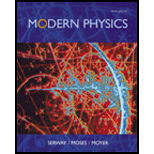
(a)
The explanation for the optical properties of metal.
(a)
Answer to Problem 1Q
Metals are opaque to visible light.
Explanation of Solution
Metals can absorb visible light. Again, visible can be scattered by the free electron inside the metal. As a result visible light can be easily absorbed by the metals.
Hence, Metals are opaque to the visible light.
(b)
The explanation for the optical properties of semiconductor.
(b)
Answer to Problem 1Q
Semiconductors are opaque to visible light however transparent to infrared.
Explanation of Solution
For semiconductor, the valance band can absorb the visible light as it has enough energy. As a result, the electrons can move from valance band to
On other hand, the infrared is not has enough energy to get absorb by semi-conductor. Hence,
(c)
The explanation for the optical properties of insulator.
(c)
Answer to Problem 1Q
Many insulators are transparent to visible light.
Explanation of Solution
The visible light has not has enough energy to get absorb by insulator. As a result, the electron from valance will not able to move to conduction band. Hence, the visible light can only pass through the insulator, like diamond.
Want to see more full solutions like this?
Chapter 12 Solutions
Modern Physics
- The energy gaps Eg for the semiconductors silicon and germanium are, respectively, 1.12 and 0.67 eV. Which of the following statements, if any, are true? (a) Both substances have the same number density of charge carriers at room temperature. (b) At room temperature, germanium has a greater number density of charge carriers than silicon. (c) Both substances have a greater number density of conduction electrons than holes. (d) For each substance, the number density of electrons equals that of holes.arrow_forwardFor a certain diatomic molecule, the lowest-energy photon in the vibrational spectrum is 0.17 eV.What is the energy of a photon emitted in a transition from the 5th exited vibrational energy level to the 2nd exited vibrational energy level, assuming no change in the rotational energy?arrow_forwardIn a silicon lattice, where should you look if you want to find (a) a conduction electron, (b) a valence electron, and (c) an electron associated with the 2p subshell of the isolated silicon atom?arrow_forward
- As the doping density of a semiconductor increases, the :mobility generally Stays the same Increases Decreases First increases, then decreases First decreases, then increasesarrow_forwardWhen a photon enters the depletion zone of a p-n junction, the photon can scatter from the valence electrons there, transferring part of its energy to each electron, which then jumps to the conduction band. Thus, the photon creates electron–hole pairs. For this reason, the junctions are often used as light detectors, especially in the x-ray and gamma-ray regions of the electromagnetic spectrum. Suppose a single 662 keV gamma-ray photon transfers its energy to electrons in multiple scattering events inside a semiconductor with an energy gap of 1.1 eV, until all the energy is transferred. Assuming that each electron jumps the gap from the top of the valence band to the bottom of the conduction band, find the number of electron – hole pairs created by the process.arrow_forwardMost solar cells are semiconductor-based. If most solar radiation has a wavelength of less than 1m, what should the band gap of the solar cell material be? Silicon has a band gap of 1.14 eV. Is silicon a suitable solar cell material?arrow_forward
- How does the bandgap differ in metals, semiconductors, and insulators?arrow_forwardConsider the NaCl molecule, for which the rotational inertia is 1.30x 10-45 kg*m2. If infrared radiation with wavelength 30 μ m is Raman-scattered from a free NaCl molecule, what are the allowed wavelengths of the scattered radiation?arrow_forwardConsider a heterojunction between two semiconductormaterials, A and B, whose electron affinities are equal. Their energy band gaps are EgA= 1.0 eV and EgB= 2.0 eV. The cubic lattice constant may be assumed to be a = 6.00Å for each material, and the dielectric constant to be 10ε0 throughout the heterojunction. In all cases you may assume flat-band conditions within each material. (a) Draw the energy band edge diagram and compute ΔEC and ΔEV for this heterojunction, assuming that the electron affinity rule is valid. (b) Now suppose that both materials have a “midgap” energy at the exact midpoint of their energy band gaps, and that in each material a deviation of the Fermi level from the “midgap” energy at a heterojunction interface produces a charge density at the interface of –σ(EF-Emidgap) with σ = 1×1014q/cm2·eV. Assume that these charges in each material are separated from each other by one cubic lattice constant at the heterojunction interface. By requiring overall charge neutrality…arrow_forward
 Modern PhysicsPhysicsISBN:9781111794378Author:Raymond A. Serway, Clement J. Moses, Curt A. MoyerPublisher:Cengage Learning
Modern PhysicsPhysicsISBN:9781111794378Author:Raymond A. Serway, Clement J. Moses, Curt A. MoyerPublisher:Cengage Learning Glencoe Physics: Principles and Problems, Student...PhysicsISBN:9780078807213Author:Paul W. ZitzewitzPublisher:Glencoe/McGraw-Hill
Glencoe Physics: Principles and Problems, Student...PhysicsISBN:9780078807213Author:Paul W. ZitzewitzPublisher:Glencoe/McGraw-Hill Physics for Scientists and Engineers with Modern ...PhysicsISBN:9781337553292Author:Raymond A. Serway, John W. JewettPublisher:Cengage Learning
Physics for Scientists and Engineers with Modern ...PhysicsISBN:9781337553292Author:Raymond A. Serway, John W. JewettPublisher:Cengage Learning


